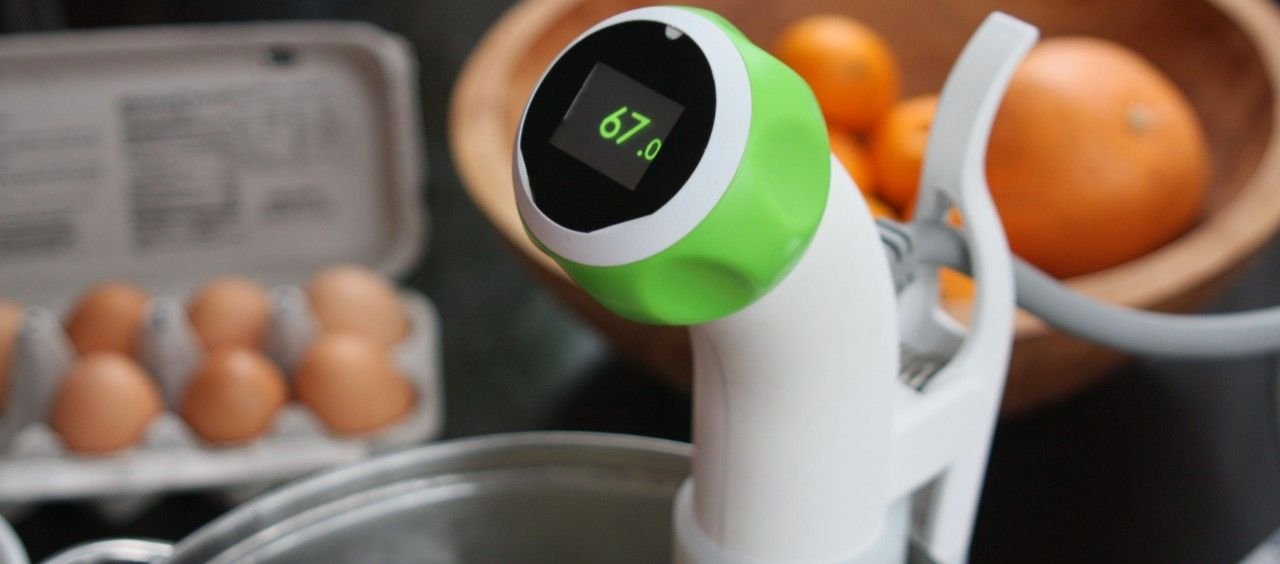I'm as food-obsessed as your average Alton Brown groupie, but couldn't imagine why I'd want a sous-vide circulator. These immersion heaters - which look similar to what you heat and aerate a fish tank with - cook vacuum-sealed food in plastic bags at low temperatures.
That doesn't look or sound appetizing, but sous-vide cheerleaders everywhere whisper of meat that could recite poetry and pork chops as tender as a young nymph's wings. And so I finally decided to see for myself if a machine that took 16 hours to cook a short rib and resembled the Green Giant's boil-in-a-bag dinners of my youth could be worth it.
Once the pet of hospitals (who used the circulators to pasteurize food) and restaurants (who use them to ensure a perfectly cooked steak every time), sous vide has finally wangled its way into hip home kitchens. In 2013, three circulators designed for home cooks came to market: the Anova, the Sansaire (which should be ready for general sale in January depending on the outcome of a patent complaint), and the Nomiku. All the home circulators are priced below $300, which is more than $700 less than the popular PolyScience model found in fancy restaurants.
I tested the Nomiku, which is small enough to fit nicely into a kitchen cabinet and is certified by Underwriters Laboratories. (It's always good to have UL's seal of approval before you plug something in and drop it into a pot of water.)
The Nomiku comes from two young people who fell in love with each other and sous-vide cooking and who were determined to make the latter available to all home cooks. Abe and Lisa Fetterman took their dream from their San Francisco home kitchen to China as part of the Haxlr8r business accelerator program "for people who hack hardware and make things," which is who the Fettermans quickly became. One week after they were married, they launched their Kickstarter campaign, using a film made by their wedding videographer. With a combination of Kickstarter and venture capital money, and 12 months slogging it out in a Chinese production facility, the first Nomiku was shipped.
The Nomiku is designed to be easy to use, and is. I chose to cook a beef brisket for my first test. I plugged in the Nomiku, clipped it onto the edge of a deep pot filled with warm tap water and set the Nomiku to stun, I mean, 135 degrees. The interface is simple: Press the screen for Fahrenheit or Celsius, spin the green knob for your desired temperature and wait. After 20 minutes the water is ready. Sous vide does mean "under vacuum," but as I don't own a vacuum sealer, I dropped my brisket into a Ziploc freezer bag along with a Korean-style marinade, and slowly immersed the bag up to the seal to remove all the air in the bag. (Thank you, Archimedes for the shortcut.)
Two hours later, the brisket, which I traditionally cook for hours in a slow cooker until it's beastly dead, was done. I removed it from the bag, dried it off, and seared it in butter over high heat in a cast-iron skillet. What had emerged from its water bath looking rather wan was now well-browned and glistening with a glaze of butter. No resting is necessary with sous vide, so I immediately sliced into the brisket. Light-pink slices fell off my knife. All my tasters (brisket snobs, if you can imagine such a thing) pronounced it perfect. One even said it was "the best," but I think she just wanted more.
All I knew was that I had a new obsession. Slow-cooker brisket usually ends up unpleasantly stringy at worst and murky and dull tasting at best. Cooked in the Nomiku, the brisket tasted like filet mignon. And while it didn't have the tenderness of a more expensive cut, it had the more delicate texture of brisket's other incarnation, pastrami.
I've always read that "you cannot overcook food in a sous vide." So I had a try at flank steak. It was ready after 90 minutes at 135 degrees, but I left it sitting in the water for three hours with the sous-vide machine burbling away, because that's the kind of sadist I can be when guests are late. When they finally arrived, I lifted the steaks out of the water, plucked them out of their bag, dried them off and seared them until brown and crusty, about two minutes on each side. The results: delicate meat with a rich, beefy flavor.
I started this kitchen journey thinking sous vide took hours and hours. In some cases, as for thick cuts of meat - short ribs or pork belly - 10-to-48 hours of cooking time is recommended to let all the connective tissues soften. But as the sous-vide mavens tout, the law is "set it and forget it," with only occasional peeks to ensure the water level is high enough.
My Nomiku turned out to be a kitchen gadget not for weekend use only. In fact, it gets more use during the week, when I have no time to pay attention to cooking. I'll toss some salmon into the sous vide, go off for 20 minutes, email my editor some excuse for not getting my work done, and can be back in the kitchen in time to remove the fish. I spend about eight minutes of active kitchen time for restaurant-quality salmon. Did I mention the salmon's melting tenderness?
One odd thing about sous vide-ing: You don't smell the food cooking. I got over that as soon as I cooked beets with the Nomiku. I had stopped cooking beets long ago because it left my house smelling like boiled dirt. (Note that I am the only one in my house happy I can now cook beets with ease.)
Nomiku also has other uses, thanks to a thermostat that goes down to 0 degrees C. It will chill your wine before you can say "Blue Nun," which may be reason enough to keep it in your cupboard.
And with the zeal of the recently converted I offer my hope that, as the price comes down on home immersion circulators and more average cooks realize sous vide's ability to simplify cooking, I believe the Nomiku and machines like it will become as standard a piece of kitchen equipment as a Cuisinart. And maybe, just maybe, beets will also be beloved by all.
























